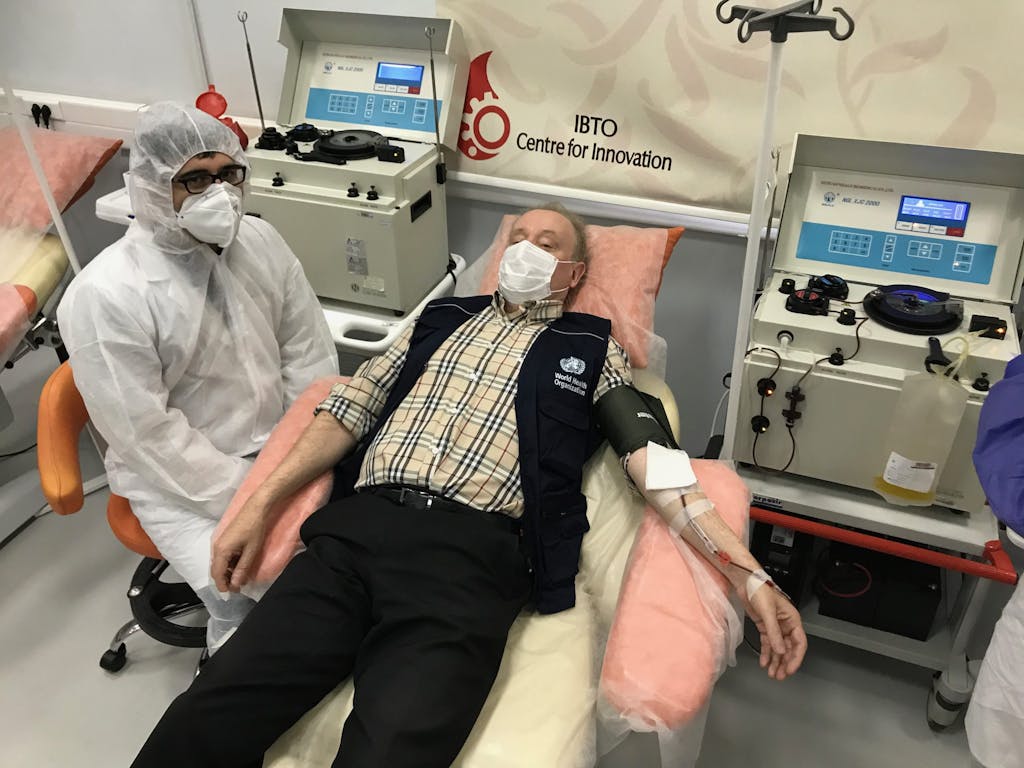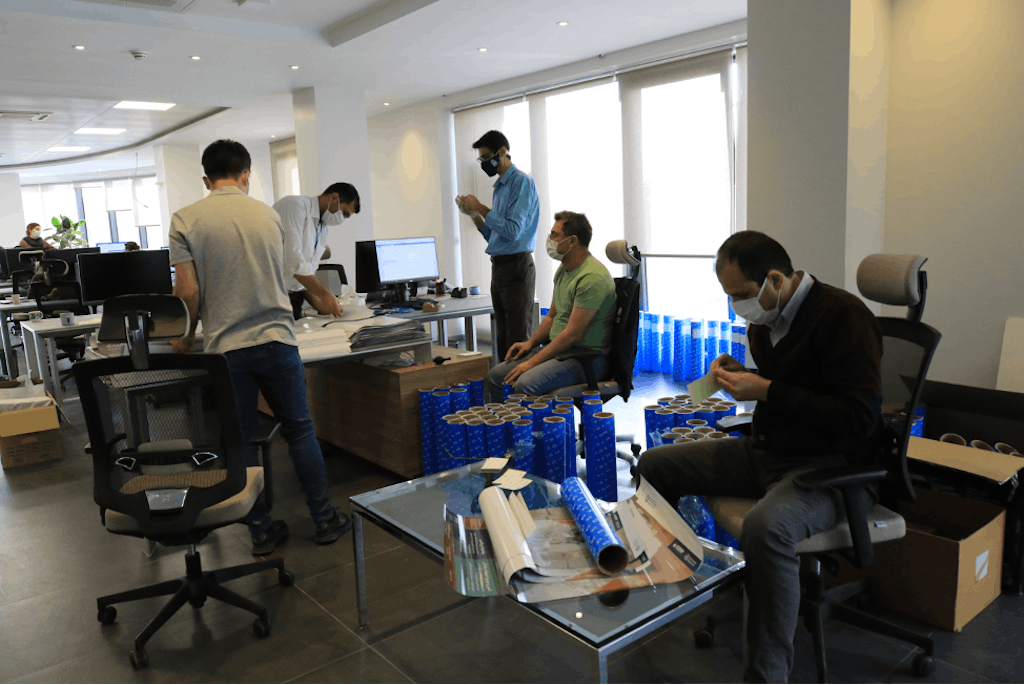After COVID-19 started spreading in China, Iran emerged as one of the first countries where the virus widely circulated, quickly surpassing infection rates of other countries at that time. Operating in a vastly different context than China or Italy, health officials had to think and work quickly to design early detection methods, communication strategies, and lockdown policies.
“There were not many examples from other countries [at that time],” said Dr. Christoph Hamelmann, the World Health Organization (WHO) representative to Iran. “China, for example, is so culturally different that we couldn’t respond in the same way. Many things had to be developed right here in the country.”
With the situation rapidly evolving on the ground in Iran, including the first COVID-positive employee on the team, the WHO country office had to brainstorm and devise its own standard operating procedures — often weeks ahead of global guidance. In early March 2020, WHO experts traveled to Iran and met with national stakeholders and health officials to plan and scale up the response to the escalating epidemic, prioritize areas for implementing control measures, and pinpoint measures to strengthen the response in areas that had not yet been affected. There was no time to waste, particularly given the risk of further cross-border spread between countries in the region and beyond.
Scaling up the emergency response
The most immediate priorities were instituting early detection, providing isolation and treatment, implementing effective contact tracing, and ensuring a strong system of risk communications in a context rife with misinformation. Since the very beginning of the pandemic, WHO continues to strengthen the COVID-19 testing capacity of the national laboratory network and provides the labs with thousands of PCR diagnostic tests. WHO also navigated logistical hurdles and global scarcity in personal protective equipment (PPE) and delivered thousands of masks and face shields, gloves, shoe covers, and other supplies to the virus-battered country. Additionally, it delivered shipments of medicines for Iran’s participation in the Solidarity Trial, one of the world’s largest studies to identify effective COVID-19 treatments.

Given that misinformation about COVID-19 was evolving as quickly as the virus itself, risk communications was another crucial element that WHO had to put in place. This was important to ensuring that any information vacuum — because the virus was so new, and sometimes, information was simply not available — was not filled with harmful rumors. Early on, for example, media outlets reported that hundreds in Iran died from drinking methanol alcohol after reading false information on social media that it was a coronavirus cure. However, as Hamelmann pointed out, misinformation is not specific to Iran but is a global phenomenon that requires a comprehensive response strategy.
“What kept me up was providing a really good and thought-through communications strategy that supported health literacy and empowered the population,” he said.

Before the pandemic, the WHO country office did not have a communications officer, but now, six people work with the Ministry of Health on risk communication strategies. With WHO acting as a neutral player in a highly politicized environment, its role helps add credibility and enhances people’s trust in health information. The team works in tandem with the WHO regional office and headquarters to develop locally relevant communications materials, including technical guidance, myth busters, and videos featuring demonstrations of preventive measures such as hand-washing, avoiding closed and crowded environments, and physical distancing.
Navigating economic sanctions
Another obstacle that Iran has had to face in its COVID-19 response is unilateral economic sanctions, which were affecting the health sector even before the pandemic started. While the WHO country office, together with other UN agencies, is supporting the Ministry of Health and Medical Education (MOHME) to mitigate the impact of the sanctions, it has been difficult to operate under such conditions, even with the more than $80 million in COVID-19 emergency procurement that the country office received for lifesaving medical and laboratory equipment from a range of donor countries and the MOHME. WHO supports the country by directly communicating with suppliers and purchasing state-of-the-art equipment and essential supplies on the global market.
The sanctions have also had a severe impact on Iran’s economy more broadly, making a full recovery more challenging.
“Iran has a lot less fiscal room to go through a lockdown,” said Hamelmann. “The country had to open earlier because it was not sustainable to remain closed. Even now, there’s very little option to go to complete lockdown if we hit another COVID-19 peak.”
When the pandemic hits home
Hamelmann himself got infected in April. At the time, he was already contemplating whether to work from home or go into the field, where he says his work is more effective.
“I prefer to schedule meetings in places where I can meet people who most need our work like hospitals and homeless centers,” he said. “People need to see my face — not just in ministry meetings but out there in the community. I need to engage not just centrally in Tehran but also within the provinces.”
When he got sick, he immediately knew it was COVID-19. “It had a certain kick against you that you knew was not normal,” he said.
At home in isolation for two weeks, he continued to work 12 hours a day to keep up with the office demands, answering emails until midnight, and editing the country’s daily COVID-19 situation report, which is distributed to international representatives in Iran, key officials and academics in the country, and UN agencies and a broad network of partners in Iran, the region, and beyond. He says he keeps a close eye on that daily update because one miscommunication could create much concern and negative repercussions in a very sensitive and politicized environment.
Hamelmann now has hope that he can support the response beyond the office. When he learned that China was using convalescent plasma therapy to treat coronavirus patients, he decided to donate his antibody-rich blood to the Iranian Blood Transfusion Organization. It’s important for WHO representatives, he says, to “walk the talk.” He hopes that with his example, he can encourage others who have overcome COVID-19 infection to donate blood for plasma therapy.
The winter ahead
At the end of November 2020, Iran had to reimplement tighter restrictions on public life, including evening curfews for all nonessential movements in major cities. Restaurants and entertainment areas were closed again. These restrictions had a positive impact, but the pressure on the health sector, the economy, and the livelihoods of many citizens remains.
The country is now looking ahead to the vaccine. While Iran doesn’t face the same level of poverty as some countries, sanctions imposed by other nations create problems that threaten equitable vaccine access for its 80 million people, including restrictions on transferring Iranian investments into the COVAX facility as a self-financing member.
“While our whole team at the country office is still working around the clock to meet the high demand for technical and procurement support in the national emergency response, the support to ensure that people living in Iran will have timely access to an affordable vaccine of high quality and [that meets] safety standard[s] has already become a new additional major focus of our work,” said Hamelmann.
CONSIDER A DONATION TODAY
Every donation makes a difference. Support WHO’s lifesaving efforts to respond to the COVID-19 pandemic by giving to the COVID-19 Solidarity Response Fund.
You can learn more about WHO’s lifesaving work around the world here and find details of how funds are used to support COVID-19 efforts here.
This article originally appeared on the World Health Organization’s webpage and has been edited and republished with permission.



 View All Blog Posts
View All Blog Posts

